Trees Birds Mammals Fish Amphibians Reptiles
Wild Algarve
Bookshop
Suillellus queletii (Schulzer) Vizzini, Simonini & Gelardi - Deceiving Bolete
Phylum: Basidiomycota - Class: Agaricomycetes - Order: Boletales - Family: Suillaceae
Distribution - Taxonomic History- Etymology - Identification - Culinary Notes - Reference Sources
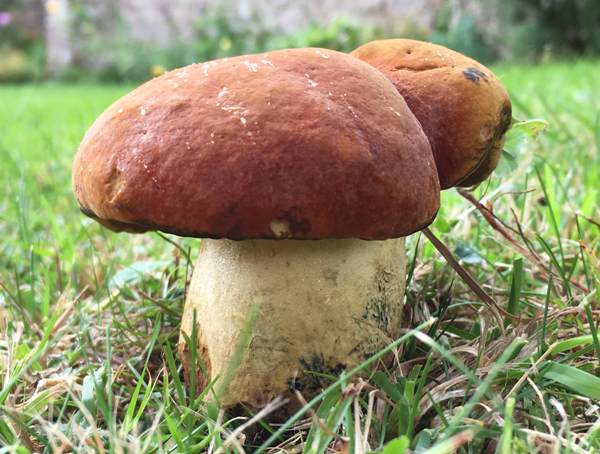
Suillellus queletii, the Deceiving
Bolete, is a very variable mushroom, and because it is quite a rare find in Britain and Ireland there is also a significant chance of errors in formal records due to misidentification.
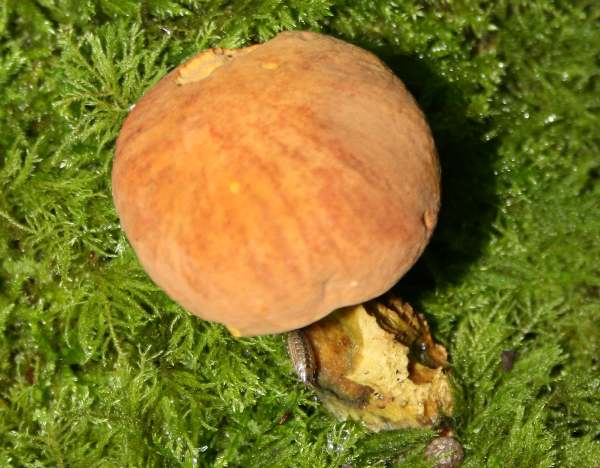
Distribution
Occasional in southern Britain but increasingly rare further north, Suillellus queletii is also found in mainland Europe, where it is most commonly seen in southern countries.
Taxonomic history
Suillellus queletii was given the name Boletus queletii in 1885 by Austro-Hungarian mycologist Stephan Schulzer von Müggenburg (1802 - 1892). In 2004, based on recent DNA analysis, Italian mycologists Vizzini, Simonini & Gelardi transferred this species to the new genus Suillellus, establishing the scientific name Suillellus queletii.
Synonyms of Suillellus queletii Schulzer include Boletus lateritius Bres. & R. Schulz, Suillellus queletii var. rubicundus Maire, and Suillellus queletii var. lateritius (Bres. & R. Schulz) E.-J. Gilbert.
Etymology
The generic name Boletus comes from the Greek bolos, meaning 'lump of clay', while the new genus name Suillellus may perhaps imply a relationship with the genus 'Suillus' - Suillus means of pigs (swine) and is a reference to the greasy nature of the caps of fungi in that genus (but not of the genus Suillellus)... confused? Me too. The specific epithet queletii is in honour of famous nineteenth-century French mycologist Lucien Quélet.
Identification guide
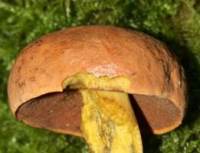 |
Cap
Deceiving Bolete caps range from 6 to 18cm across, broadly convex and eventually almost flattening; yellowish-orange, apricot-orange or reddish orange and occasionally even deeper red; surface dry and minutely pruinose at first, becoming smoother with age; bruising blue-black. |
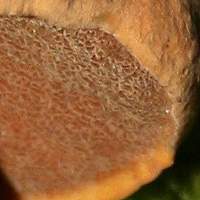 |
Tubes and Pores
The tubes, which are ochre and turn blue when cut and exposed to air, terminate in distinctive peach to apricot-orange pores.
|
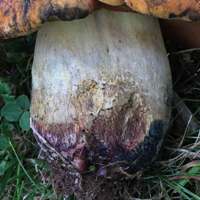 |
Stem
Stems of Suillellus queletii are solid rather than hollow, cylindrica or slightloy clavate, or more often tapered and rooting; 4 to 8cm long and 4 to 8mm in diameter, yellow at the apex, and progressively deeper red towards the base, the surface usually punctate/granular but sometimes a very faint reticule is present. |
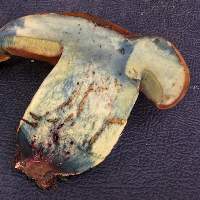 |
In the upper half of the stem the stem flesh is pale yellow, bruising blue, which the flesh in the lower half of the stem is a deep vinaceous red - almost beetroot red-purple. |
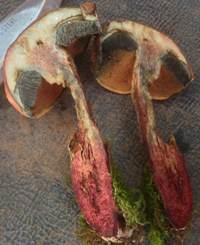 |
This feature helps to distinguish Suillellus queletii from the otherwise rather similar Scarletina Bolete Neoboletus luridiformis (syn. Boletus erythropus) whose stem flesh is nearly always yellow with little or no hint of red (although just to muddy the waters there are reports of very occasional specimens of Boletus luridiformis with some deep red fresh near to the stem base!). |
| |
Spores
Subfusiform to ellipsoidal, smooth; 9-14 x 4.5-7µm (unusually short and fat for a Boletus species); Q = 1.5-2.5.
Spore print
Olive-brown. |
Odour/taste |
Not significant. |
Habitat & Ecological role |
Suillellus queletii is an ectomycorrhizal fungus; it is usually found growing on alkaline soil beneath hardwood trees, notably oaks but also beech and limes; in mainland Europe this bolete has also been recorded with birches. |
Season |
July to October in Britain and Ireland. |
Similar species |
Suillellus luridus has a distinct reticule on its stem (and larger spores).
Neoboletus luridiformis has generally yellow stem flesh (and larger spores). |
Culinary Notes
Although reported to be edible, Suillellus queletii is a rare find in Britain and so the fruitbodies are surely best left for others to enjoy.
Reference Sources
Fascinated by Fungi, 2nd Edition, Pat O'Reilly 2016, reprinted by Coch-y-bonddu Books in 2022.
British Boletes, with keys to species, Geoffrey Kibby (self published) 3rd Edition 2012
BMS List of English Names for Fungi
Estadès, A. & Lannoy, G. 2004. Les bolets européens. – Bulletin Mycologique et Botanique Dauphiné-Savoie 44(3): 3–79.
Roy Watling & Hills, A.E. 2005. Boletes and their allies (revised and enlarged edition), - in: Henderson, D.M., Orton, P.D. & Watling, R. [eds]. British Fungus Flora. Agarics and boleti. Vol. 1. Royal Botanic Garden, Edinburgh.
Knudsen, H. & Vesterholt, J. [eds.]. 2008. Funga Nordica. Nordsvamp, Kopenhagen.
Dictionary of the Fungi; Paul M. Kirk, Paul F. Cannon, David W. Minter and J. A. Stalpers; CABI, 2008
Taxonomic history and synonym information on these pages is drawn from many sources but in particular from the British Mycological Society's GB Checklist of Fungi.
Acknowledgements
This page includes pictures kindly contributed by Simon Harding.
Top of page...
Fascinated by Fungi. Back by popular demand, Pat O'Reilly's best-selling 450-page hardback book is available now. The latest second edition was republished with a sparkling new cover design in September 2022 by Coch-y-Bonddu Books. Full details and copies are available from the publisher's online bookshop...